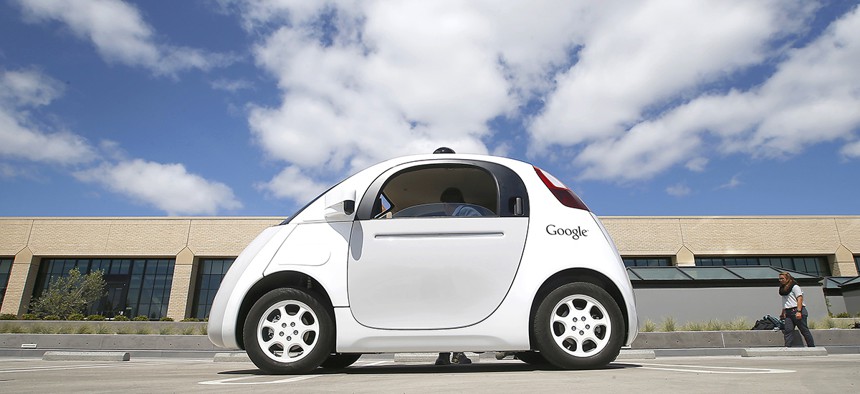Why Driverless Cars Are Like Elevators

Google's new self-driving prototype car during a demonstration at the Google campus in Mountain View, Calif. Tony Avelar/AP File Photo
It's another magic box with buttons in it.
One of the challenges in describing the potential of self-driving cars is that they promise to do so much. Technologies that save lives, decimate and create entire industries, and uproot long-held perceptions of space and time don’t come around very often.
Which is part of why it can be useful to try to think about driverless cars in the context of technological revolutions of the past. If this moment in technological history is indeed pivotal, which other transformative moment in technological history is it most like?
In the past few months, I’ve posed this question to dozens of engineers, scholars, and executives who are focused on self-driving cars. Three answers came up repeatedly.
The first two answers aren’t all that surprising: The dawn of self-driving cars reminds a lot of people of a time when the original automobiles were in their infancy. Airplanes, too. (“When I rode in the Google car last summer, I felt like I was at Kitty Hawk,” the Massachusetts Institute of Technology engineering professor John Leonard told me, referring to the site of the Wright brothers’ famous airplane test flights in 1903.)
The third response was a bit more unusual.
“Another related technology, in a lot of ways, is the elevator,” said Chris Urmson, the head of Google’s self-driving-car project. “It’s another technology that had a fairly profound impact on cities.”
Urmson’s not the only one to make this comparison. Elon Musk, the CEO of Tesla, has compared driverless cars to elevators, too.
Elevators didn’t just change people’s perceptions, they changed how humans physically move through buildings and cities. Whereas it was once more desirable to live and work closer to the ground—as someone who once lived on the seventh floor of a walk-up in New York, I know this to be true—elevators made higher floors more desirable.
Elevators also enabled architects to build up, up, up. The vertical aesthetic of the modern city, skyscraper-dotted horizons that double as distinct urban signatures, exist because of elevators. They created a new, and often socially awkward, kind of public space—one that feels simultaneously intimate, fleeting, and unpredictable, even as passengers know exactly where they are going.
And elevators themselves have changed over time, as The Boston Globe pointed out last year: “Trained operators armed with cranks and levers have been replaced with buttons; motion sensors have made holding the door less of a heroic act.”
It’s no mistake that Urmson and Musk, both of whom are dedicated to bringing driverless cars to the masses, would offer a comparison that highlights acutely how technological change and cultural change intersect—and, more specifically, how quickly a technology can go from seeming extraordinary to mundane.
“There’s another really interesting parallel in the way they were introduced,” Urmson told me. “The technology was this magic thing that would whisk you up floors. You couldn’t possibly imagine relinquishing your life to this thing. So it was people’s job to sit in the elevator and press the button for you—because it was so complicated. People grew accustomed to it, and they realized they didn’t really need the person there to press the button.”
In other words, the message is, if you’ve ever taken for granted an elevator, perhaps someday a self-driving car will be similarly ho-hum. Just another box you climb into, with buttons to press, that used to be awe-inspiring but isn’t anymore.
If and when that happens, people are likely to see human-driven cars differently, too. “People may outlaw driving cars because it’s too dangerous,” Musk said at a developer’s conference in California earlier this year. “You can’t have a person driving a two-ton death machine.”
NEXT STORY: Video: Car Crash Testing Goes Virtual


